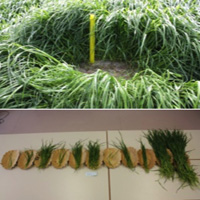Morphological development, herbage yield and quality of Italian ryegrass during primary growth and regrowth: Regression models and yield optimisation

Accepted: 3 October 2019
HTML: 122
All claims expressed in this article are solely those of the authors and do not necessarily represent those of their affiliated organizations, or those of the publisher, the editors and the reviewers. Any product that may be evaluated in this article or claim that may be made by its manufacturer is not guaranteed or endorsed by the publisher.
The main aim of this research was to establish simple regression models for predicting herbage production parameters during uninterrupted growth and to contribute to forage optimisation of Italian ryegrass (Lolium multiflorum Lam.) cultivated as an overwinter catch crop. The field experiment in split-plot design with two block replicates consisted of two growth cycles: primary growth (C1) and regrowth (C2) as the whole plots, and twelve time series with five-day intervals as the sub-plots. For each time point, herbage dry matter yield, mean stage by weight (MSW) and contents of crude protein (CP) and net energy for lactation (NEL) were determined. Growth days for all production parameters and MSW for quality parameters were used as explanatory variables. Considering the practically relevant 47-day growth period, simple linear regression models explained from 84.9% to 94.0% of the variance of the investigated parameters. These models are better than those performed for the whole 67-day period, except for the model for MSW-based prediction of CP content. The comparison of the two predictors showed that growth days were at least as good as MSW in predicting CP and NEL contents determined during C1 and C2. The effect of growth cycle on the patterns of all investigated parameters was significant, indicating that growth conditions played an important role. Based on our results, CP and NEL yield potentials of Italian ryegrass cannot be completely exploited in a double catch crop system if the required forage quality for lactating cows is to be respected. It rather suggests getting the maximal single harvest in early May, which is justified from nutritional and economical standpoints.
How to Cite

This work is licensed under a Creative Commons Attribution-NonCommercial 4.0 International License.
PAGEPress has chosen to apply the Creative Commons Attribution NonCommercial 4.0 International License (CC BY-NC 4.0) to all manuscripts to be published.

 https://doi.org/10.4081/ija.2019.1497
https://doi.org/10.4081/ija.2019.1497



